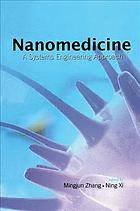
Nanomedicine : a systems engineering approach PDF
Preview Nanomedicine : a systems engineering approach
V019tp.indd 1 12/4/08 11:54:40 AM edited by Mingjun Zhang The University of Tennessee, USA Ning Xi Michigan State University, USA V019tp.indd 2 12/4/08 11:54:40 AM Published by Pan Stanford Publishing Pte. Ltd. Penthouse Level, Suntec Tower 3 8 Temasek Boulevard Singapore 038988 Email: [email protected] Web: www.panstanford.com British Library Cataloguing-in-Publication Data A catalogue record for this book is available from the British Library. NANOMEDICINE A Systems Engineering Approach Copyright © 2009by Pan Stanford Publishing Pte. Ltd. All rights reserved. This book, or parts thereof, may not be reproduced in any form or by any means, electronic or mechanical, including photocopying, recording or any information storage and retrieval system now known or to be invented, without written permission from the Publisher. For photocopying of material in this volume, please pay a copying fee through the Copyright Clearance Center, Inc., 222 Rosewood Drive, Danvers, MA 01923, USA. In this case permission to photocopy is not required from the publisher. ISBN978-981-4241-36-6(Hardcover) ISBN978-981-4241-37-3(eBook) Printed in Singapore. RPS Nanomedicine:ASystemsEngineeringApproach “FM” 2008/12/15 v Preface Thepurposeofthiseditedvolumeistopromptquantitativesciences tothefastemergingfieldofnanomedicine. Nanomedicine currently faces two challenges. The first is to quantitatively describe drug effects at the micro-/nano-scale, par- ticularly,bytakingintoconsiderationdynamicinteractionsofdrugs withbiologicalsystemsatthemolecularlevel.Thesecondistopre- ciselycontrolthedrugeffects,especiallythecoupledeffectsofdrugs withthecomplexbiologicalsystem. Systemsengineeringapproachcanhelpaddresstheabovechal- lenges.Dynamicsmodeling,controlandoptimizationareimportant componentsofsystemengineering.Theyhavebeenappliedsuccess- fullyinmanyengineeringdisciplinary.Unfortunately,applications ofsystemsengineeringapproachtonanomedicinehasjuststarted. This book puts together case studies of systems engineering to the field of nanomedicine. It contains eight chapters ranging from introductiontonanomedicine,fundamentalsofmathematicalmod- eling,toapplicationsinsignalpathway,tumortherapy,multi-scale biologicalsystemmodelingandcontrolleddrugdelivery. Itischallengingtoeditsuchahighlyinterdisciplinarybook.We areluckytohaveadedicatedteamofoutstandingcontributors,and avisionaryeditorialteam.Wewouldliketotakethisopportunityto thankallthecontributorsfortheirexcellentcontributions,Mr.Stan- fordChongandMr.RhaimieWahapfortheiroutstandingsupport. Theyarethedirectcontributorstothesuccessofthisbook. Down to the road, we firmly believe personalized and quan- titative aspects of medicine are two fundamental challenges to nanomedicine. Systems engineering approach will play an impor- tantroleintheendeavor. Wewelcomeanycommentsandsuggestionsfromthereaders. MingjunZhangandNingXi RPS Nanomedicine:ASystemsEngineeringApproach “FM” 2008/12/15 vii List of Contributors AdrivanDuin ................................................245 AndresJaramillo-Botero.......................................245 AniruddhSolanki ............................................... 1 HermannB.Frieboes ......................................... 201 JohnD.Kim.....................................................1 JohnP.Sinek .................................................. 201 JongjinJung.....................................................1 Jr-ShinLi.......................................................81 JuanyiYu . . . . . . . . . . . . . . . . . . . . . . . . . . . . . . . . . . . . . . . . . . . . . . . . 81 KarenSachs...................................................143 Ki-BumLee......................................................1 MauroFerrari.................................................201 MingjunZhang.........................................39,81,301 NingXi........................................................117 PaoloDecuzzi.................................................201 RavinderAbrol................................................245 RuiGao........................................................81 SharonBewick.............................................39,301 SolomonItani.................................................143 Tzyh-JongTarn.................................................81 VittorioCristini ............................................... 201 WilliamA.GoddardIII ................................... 245,301 WilliamR.Hamel .............................................. 39 YantaoShen...................................................117 RPS Nanomedicine:ASystemsEngineeringApproach “FM” 2008/12/15 ix Contents Preface ..................................................... v ListofContributors ........................................ vii Chapter1................................................... 1 Nanomedicine:DynamicIntegrationof NanotechnologywithBiomedicalScience Ki-BumLee,AniruddhSolanki,JohnD.KimandJongjinJung Chapter2................................................... 39 FundamentalMathematicalModelingTechniquesfor NanoBio-Systems SharonBewick,MingjunZhangandWilliamR.Hamel Chapter3................................................... 81 AMathematicalFormulationoftheCentralDogmaof MolecularBiology RuiGao,JuanyiYu,MingjunZhang,Tzyh-JongTarnand Jr-ShinLi Chapter4................................................... 117 SystemApproachtoCharacterizeLivingDrosophila EmbryosforBiomedicalInvestigations YantaoShenandNingXi Chapter5................................................... 143 LearningSignalingPathwayStructures KarenSachsandSolomonItani Chapter6................................................... 201 ComputationalModelingofTumorBiobarriers: ImplicationsforDeliveryofNano-BasedTherapeutics HermannB.Frieboes,PaoloDecuzzi,JohnP.Sinek,Mauro FerrariandVittorioCristini Nanomedicine:ASystemsEngineeringApproacheditedbyMingjunZhang&NingXi Copyright©2009byPanStanfordPublishingPteLtd www.panstanford.com 978-981-4241-36-6 RPS Nanomedicine:ASystemsEngineeringApproach “FM” 2008/12/15 x M.ZhangandN.Xi Chapter7................................................... 245 Multiscale-MultiparadigmModelingandSimulation ofNanometerScaleSystemsandProcessesfor NanomedicalApplications AndresJaramillo-Botero,RavinderAbrol,AdrivanDuinand WilliamA.GoddardIII Chapter8................................................... 301 GameTheoreticalFormulationoftheImmuneSystem andInspirationforControlledDrugDelivery Application SharonBewick,MingjunZhangandWilliamR.Hamel ColorIndex................................................. 335 SubjectIndex............................................... 345 x Contents RPS Nanomedicine:ASystemsEngineeringApproach “ch01” 2008/7/30 1 Chapter One Nanomedicine: Dynamic Integration of Nanotechnology with Biomedical Science AJKonih-iBnruuDdm.dKLheiSmeo∗,laanndkJi,ongjinJung ...................... 1.1 INTRODUCTION Therecentemergenceofnanotechnologyissettinghighexpectations in biological science and medicine, and many scientists now pre- dictthatnanotechnologywillsolvemanykeyquestionsofbiologi- calsystemsthattranspireatthenanoscale.Nanomedicine,broadly definedastheapproachofscienceandengineeringatthenanome- ter scale toward biomedical applications, has been drawing con- siderable attention in the area of nanotechnology. Given that the sizes of functional elements in biology are at the nanometer scale range,itisnotsurprisingfornanomaterialstointeractwithbiolog- icalsystemsatthemolecularlevel.Inaddition,nanomaterialshave novel electronic, optical, magnetic, and structural properties that cannotbeobtainedfromeitherindividualmoleculesorbulkmateri- als.Theseuniquefeaturescanbepreciselytunedinorderforscien- tists to explore biological phenomena in many ways. For instance, extensivestudieshavebeendonewithchip-basedorsolution-based bio-assays,drugdelivery,molecularimaging,diseasediagnosis,and ∗ Correspondingauthor. Nanomedicine:ASystemsEngineeringApproach ©PanStanfordPublishing www.panstanford.com 978-981-4241-36-6 RPS Nanomedicine:ASystemsEngineeringApproach “ch01” 2008/7/30 2 M.ZhangandN.Xi pharmaceutical screening.1−4 In order to realize these applications, it is crucial to develop methods that investigate and control the binding properties of individual biomolecules at the fundamental nanometerlevel.Thiswillrequireenormoustime,effort,andinter- disciplinaryexpertiseofphysicalsciencesassociatedwithbothbiol- ogyandengineering.Theoverallgoalofnanomedicineistodevelop safer and more effective therapeutics as well as novel diagnostic tools. To date, nanotechnology has revolutionized biomedical sci- encestepbystepnotonlybyimprovingefficiencyandaccuracyof currentdiagnostictechniques,butalsobyextendingscopesforthe better understanding of diseases at the molecular level.5−8 In this chapter,nanomaterialsandtheirapplicationsinbiomedicalresearch willbediscussed. 1.2 DESIGNINGNANOMATERIALSFORBIOLOGY ANDMEDICINE Oneoftheimportanttechnologicalaspectsinnanomedicineliesin theabilitytotunematerialsinawaythattheirspatialandtemporal scales are compatible with biomolecules. That said, materials and devices fabricated at the nanometer scale can investigate and con- troltheinteractionsbetweenbiomoleculesandtheircounterpartsat almost the single molecule level. This, in turn, indicates that nano- materialsandnanodevicescanbefabricatedtoshowhighsensitivity, selectivity,andcontrolproperties,whichusuallycannotbeachieved in bulk materials. The wide range of the scale of biointeractions is describedinFig.1. Given that one of the major goals of biology is to address the spatial-temporal interactions of biomolecules at the cellular or integrated systems level, the integration of nanotechnology in biomedicine would bring a breakthrough in current biomedical research efforts. In order to apply nanotechnology to biology and medicine,severalconditionsmustbeconsidered:(i)nanomaterials shouldbedesignedtointeractwithproteinsandcellswithoutper- turbingtheirbiologicalactivities,(ii)nanomaterialsshouldmaintain theirphysicalpropertiesafterthesurfaceconjugationchemistry,and (iii)nanomaterialsshouldbebiocompatibleandnon-toxic. In general, there are two approaches to build nanostructures or nanomaterials: “top-down” and “bottom-up” methods. Typ- ically, the bottom-up approach utilizes self-assembly of one or 2 K.-B.Leeetal. RPS Nanomedicine:ASystemsEngineeringApproach “ch01” 2008/7/30 3 Nanomedicine: ASystemsEngineeringApproach Figure1. Scaleofbiomolecularinteractions. more defined molecular building blocks to create higher-ordered functional entities. For the bottom-up approach, the physical and chemical criterion, such as pH, concentration, temperature, and intrinsic properties of building blocks, must be fulfilled. On the other hand, the top-down approach usually involves processes such as lithography, etching, and lift-off techniques to fabricate micro-andnanoscopicstructuredmaterialsfrombulkmaterials.In manycases,nanomedicinestrategieshavebeenderivedfromwhat was originally a conventional biomedical application, with a cer- tain degree of modification to address some scientific questions or technical limitations. As far as the applications of nanostructures are concerned, we will examine two examples, nanoparticles and nanoarrays/biochips, which are heavily used in biomedical applications. 1.2.1 InorganicNanoparticles Deoxyribonucleic acid (DNA), ribonucleic acid (RNA), peptides, andproteinsarenanometerscalecomponentsthatarethebestexam- ples of nanomaterials found in nature.9,10 For example, DNA has a double-stranded helical structure with a diameter of 2nm, RNA Nanomedicine:DynamicIntegrationofNanotechnologywithBiomedicalScience 3
